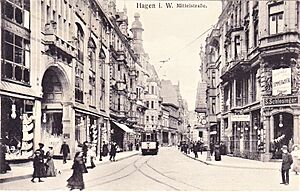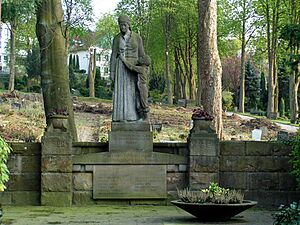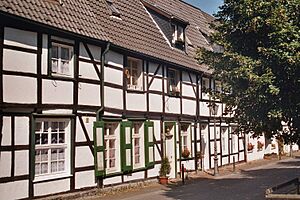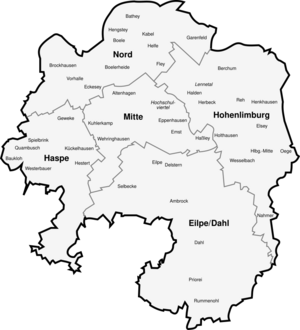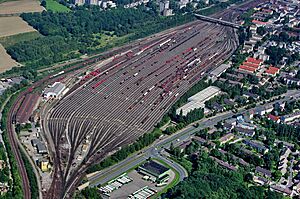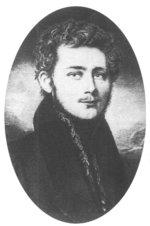Hagen facts for kids
Quick facts for kids
Hagen
|
|||
|---|---|---|---|

Old town hall tower between the two shopping centres, January 2020
|
|||
|
|||
| Country | Germany | ||
| State | North Rhine-Westphalia | ||
| Admin. region | Arnsberg | ||
| District | Urban district | ||
| Elevation | 106 m (348 ft) | ||
| Population
(2022-12-31)
|
|||
| • Total | 189,783 | ||
| Time zone | CET/CEST (UTC+1/+2) | ||
| Postal codes |
58089–58099, 58119, 58135
|
||
| Dialling codes | 02331, 02334, 02337, 02304 | ||
| Vehicle registration | HA | ||
| Website | www.hagen.de | ||
Hagen is a city in the German state of North Rhine-Westphalia. It is located on the southeastern edge of the Ruhr area. Hagen is about 15 kilometers south of Dortmund. Here, the rivers Lenne and Volme meet the Ruhr. In 2023, about 197,677 people lived in Hagen.
Hagen is special because it has the FernUniversität Hagen. This is Germany's only state-funded university for distance education. This means students can learn from home.
Contents
Exploring Hagen's Geography
Hagen's city area stretches about 17.1 kilometers from north to south. It is 15.5 kilometers wide from west to east. The city's border is 89.7 kilometers long. It touches Dortmund and other districts. The total area of Hagen is 160.36 square kilometers. This is about the same size as the country of Liechtenstein.
A large part of Hagen is covered by forests. About 42 percent of the city's land is forest. Four rivers flow through Hagen. The Ruhr is 11.5 km long in Hagen. The Lenne is 13.1 km, the Volme is 21.3 km, and the Ennepe is 6.3 km. The city has different heights. The lowest point is 86 meters above sea level. The highest point is 438 meters above sea level.
What Fossils Tell Us About Hagen
Since the early 1800s, the Hagen area has been famous for its fossils and archaeology. Many ancient animal and plant remains have been found here.
The ground in Hagen has different types of rocks. These rocks formed from the Devonian to the Carboniferous periods. In some caves made of limestone, scientists found deposits from later periods. These include the Cretaceous, Tertiary, and Holocene times.
Other fossil sites in Hagen have helped us learn about Earth's history. Bones of land dinosaurs and early mammals were found here. Also, plant remains from the Lower Cretaceous period were discovered.
The former Hagen-Vorhalle brickworks quarry is very important. It is known for fossilized insects. Scientists found early large dragonflys with wingspans of 40 cm. They also found extinct butterflies and giant centipedes. These fossils are from the Upper Carboniferous period. The Hagen-Vorhalle quarry is a globally important site for fossil research. You can see these finds at the Museum of Prehistory and Early History. It is located in Werdringen moated castle.
In a valley near Holthausen, remains of Stone Age people were found. These were in a cave called ‘Blätterhöhle’. They are about 11,300 years old. This makes them the oldest proof of modern humans in Europe after the last Ice Age.
Hagen's Journey Through Time
Medieval Beginnings
The Hagen area first appeared in history books around 775. This was when Charlemagne's army took over Hohensyburg castle. This castle was near what is now Dortmund.
Hagen itself was first mentioned around the year 1200. It was likely the name of a farm. This farm was where the Volme and Ennepe rivers met. Later, in 1324, Hagen became part of the County of Mark.
Early Modern Times and Growth
After a treaty in 1614, Hagen became part of Margraviate of Brandenburg. This area later became part of the Kingdom of Prussia in 1701.
In 1724, a big fire destroyed much of Hagen. But with help from the Prussian government, the city was quickly rebuilt. Hagen officially became a town on September 3, 1746.
The 19th and Early 20th Centuries
After Prussia lost a war in 1807, Hagen was part of the Grand Duchy of Berg. This was a state created by France. In 1815, Hagen became part of the new Province of Westphalia.
Hagen became an important railway hub in 1848. This happened during the time of industrial growth. By 1865, Hagen had grown bigger than Iserlohn. Iserlohn used to be the main town in South Westphalia.
From 1871 to 1914, Hagen became very rich. It grew into the main center for the region south of the Ruhr river. In 1887, Hagen became an independent city.
Around the turn of the century, a banker named Karl Ernst Osthaus helped Hagen become famous for art and architecture. He brought important architects like Henry van de Velde and Walter Gropius to the city. They helped create a link between Art Nouveau and Modernism. The Museum Folkwang was a key part of this effort.
In March 1920, there was an event called the Kapp Putsch. Some right-wing groups tried to take over the government. In response, many workers in the Ruhr Valley started an uprising. This was called the Ruhr uprising. About 50,000 workers formed the Ruhr Red Army. They took control of the industrial area. The government sent forces to stop them. Sadly, about 1,000 workers died. A memorial in Hagen remembers this event.
By 1928, Hagen had grown to have more than 100,000 people.
Hagen During World War II
During World War II, Hagen was bombed many times. The Royal Air Force and the US Eighth Air Force attacked the city. On October 1, 1943, the Royal Air Force heavily bombed Hagen. The city was badly damaged, and many people died. After the war, the city center was almost completely destroyed.
More than 2,200 people died in Hagen from bombings between 1940 and 1945. Over 10,000 Hagen citizens died fighting in the war. Many others were killed in concentration camps and prisons. This was because of their race, religion, beliefs, or politics.
In 2021, some old items from the Nazi era were found in a house in Hagen. These included a portrait of Adolf Hitler and medals with eagles and swastikas. The house was once a headquarters for a Nazi organization.
After the War
In April 1945, the US Army took control of Hagen. Later, it became part of the British occupation zone. In 1948, Hagen joined the new state of North Rhine-Westphalia. Then, in 1949, it became part of West Germany.
In the 1950s and 1960s, Hagen grew quickly again. The city expanded into the flatter areas to the north.
Recent Times: Challenges and Changes
In the early 1970s, Hagen's heavy industry started to decline. This was due to problems in the steel crisis. Many factories closed, and jobs were lost. Other industries, like food production, also faced difficulties.
In the 1970s, a pedestrian zone was opened in the city center.
In the early 1980s, Hagen became known as the 'Liverpool of New German Wave'. This was a popular music style. Many famous musicians and bands came from Hagen. These included Nena, Extrabreit, and the sisters Annette and Inga Humpe.
In the 1990s, Hagen faced more economic challenges. More steel factories closed. The number of people living in Hagen also started to go down. The city also had a lot of debt.
Since the 2000s, Hagen has seen many new building projects. These have changed the city's look. Examples include new shopping centers and redesigned public squares.
In July 2021, Hagen was hit by a big flood. Heavy rainfall caused a lot of damage, especially in the Volme valley.
Hagen's Economy
Hagen has a long history with metal processing. This was important even before the 15th century. The rivers provided power for factories. In the 17th and 18th centuries, textile and steel industries grew. Paper production also became important.
Today, Hagen is home to the Suedwestfaelische Industrie- und Handelskammer. This is a chamber of industry and commerce. It also has Sparkasse Hagen, a local public savings bank.
The city has faced financial challenges. It is working to reduce its debt by cutting some city services. Hagen is also known for exporting different kinds of bread. A famous one is Hagenschmagenbrot, a traditional dark bread.
Learning in Hagen
One of the five campuses of South Westphalia University of Applied Sciences is in Hagen. This university offers many engineering programs. It was first started in the city in 1824.
Places to Visit in Hagen
Hagen has the LWL-Freilichtmuseum Hagen. This is an open-air museum with old industrial buildings. You can see how trades like printing, brewing, and blacksmithing used to work. Visitors can even take part in some activities. It is located near the Hagen community of Eilpe.
The Historisches Centrum Hagen includes the city museum and Werdringen castle. In the Blätterhöhle cave in Hagen, the oldest human fossils in Westphalia were found. Some of these date back to 10,700 BCE. This shows that people in this area lived by hunting and gathering for a long time. They continued this lifestyle even after farming societies arrived.
Hagen's Boroughs
Hagen is divided into five main boroughs. These are further split into smaller quarters.
| Borough | Area in km2 |
Population Dec 2017 |
Inhabitants per km2 |
|---|---|---|---|
| HA-Mitte | 20.5 | 79.782 | 3.892 |
| HA-Nord | 29.6 | 38.092 | 1.287 |
| HA-Hohenlimburg | 37.0 | 29.477 | 796 |
| HA-Eilpe/Dahl | 51.1 | 16.853 | 330 |
| HA-Haspe | 22.2 | 31.008 | 1.397 |
Some of the quarters in Hagen include:
- Hagen-Mitte: Mittelstadt, Wehringhausen, Altenhagen, Emst
- Hagen-Nord: Boele, Eckesey, Vorhalle, Kabel, Helfe
- Hagen-Hohenlimburg: Hohenlimburg, Elsey, Holthausen, Halden
- Hagen-Eilpe/Dahl: Eilpe, Selbecke, Dahl, Rummenohl
- Hagen-Haspe: Haspe, Westerbauer, Quambusch
Who Lives in Hagen?
Hagen became a "Großstadt" (large city) in 1928. This means its population went over 100,000. In 1964, it passed 200,000 people. The highest population was in 1975, with 231,840 residents.
Since 2005, the population has been below 200,000. In 2012, it reached a low point of 187,810 people. But since then, the number has been growing again. In 2021, more people moved into Hagen than moved out.
On December 31, 2023, Hagen had 197,677 people. This included 150,505 Germans and 47,172 people from other countries. Hagen is the 41st largest city in Germany by population.
In 2023, about 20.3% of Hagen's population was under 20 years old. About 28.8% were 60 years or older. In 2023, 23.9% of the people in Hagen were from other countries. In 2021, 34.1% of Hagen's population had a family background from another country.
In March 2021, many children in daycare centers had a migrant background. Also, many children spoke a language other than German at home.
The unemployment rate in Hagen in October 2022 was 12.1%. This was higher than the average for North Rhine-Westphalia.
Here are the largest groups of foreign residents in Hagen (as of 2017):
| Rank | Nationality | Population (31.12.2017) |
|---|---|---|
| 1 | 7,196 | |
| 2 | 3,558 | |
| 3 | 3,175 | |
| 4 | 2,534 | |
| 5 | 1,481 | |
| 6 | 1,082 | |
| 7 | 928 | |
| 8 | 876 | |
| 10 | 710 | |
| 11 | 678 | |
| 12 | 543 |
Getting Around Hagen
Major highways like the A1, A45, and A46 pass by Hagen.
Hagen has been an important train hub since 1848. The marshalling yard of Hagen-Vorhalle is one of Germany's largest. The central station connects to high-speed trains (ICE). It also has local and S-Bahn train services. Since 2005, Hagen has been a starting point for the Ruhr-Lenne-Express train service.
Local transport in Hagen is handled by Hagener Straßenbahn. Despite its name, it only offers bus services now. The last tram line in Hagen closed in 1976. There is a large network of 36 bus lines in Hagen. All local train and bus services are part of the VRR transport association.
Sports in Hagen
The German Basketball Federation (DBB) has its main office in Hagen.
Some sports clubs in Hagen include:
- TSV Hagen 1860 - This is the largest club. They have won many championships in fistball.
- SSV Hagen - This club won the basketball championship in 1974. It was later known as Brandt Hagen.
- SSV Hagen - This club offers football, cycling, jiu-jitsu, and more. Their football team plays at the Ischelandstadion.
- Phoenix Hagen - This is a professional basketball team.
- Hasper SV
- Hohenlimburger SV - This club has won many women's water polo championships.
Hagen is also known for its annual horse show, 'Horses & Dreams'. It happens every April. This is one of the biggest horse shows in Germany. In 2005, Hagen hosted the European Dressage Championships. It will host them again in 2021.
Hagen's Sister Cities
Hagen has special connections with other cities around the world. These are called sister cities.
 Liévin, France (since 1960)
Liévin, France (since 1960) Finland Kouvola (Finland), (1963–2009)
Finland Kouvola (Finland), (1963–2009) Montluçon, France (since 1965)
Montluçon, France (since 1965) Steglitz-Zehlendorf (Berlin), Germany (since 1967)
Steglitz-Zehlendorf (Berlin), Germany (since 1967) Bruck an der Mur, Austria (since 1974)
Bruck an der Mur, Austria (since 1974) Smolensk, Russia (since 1985)
Smolensk, Russia (since 1985) Modi'in-Maccabim-Re'ut, Israel (since 1997)
Modi'in-Maccabim-Re'ut, Israel (since 1997)
Famous People from Hagen
Many notable people were born or lived in Hagen, including:
- Freddy Breck (1942–2008), a percussionist.
- Wilhelm Böing (1846–1890), whose son, William E. Boeing, founded the Boeing aviation company.
- Mousse T. (born 1966), a famous DJ and music producer.
- Karl Halle (1819–1895), a pianist and orchestra conductor.
- Friedrich Harkort (1793–1880), a pioneer in railways and industry.
- Annette Humpe (born 1950), a music producer and singer.
- Nena (born 1960), a well-known pop singer.
- Karl Ernst Osthaus (1874–1921), a banker who supported modern art and architecture.
- Emil Schumacher (1912–1999), a famous abstract painter.
- Henning Wehn (born 1974), a comedian.
Images for kids
See also
 In Spanish: Hagen para niños
In Spanish: Hagen para niños





